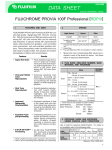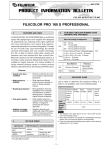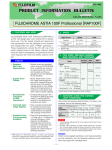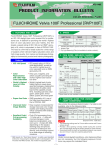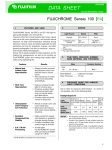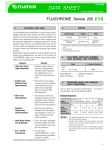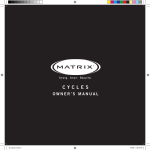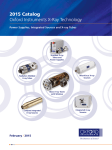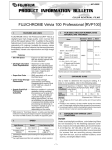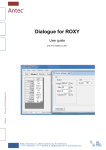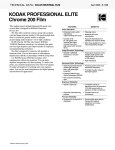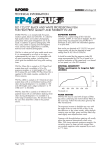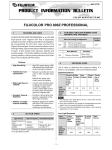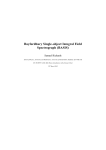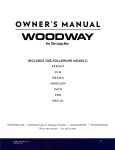Download Fujifilm 1x5 Provia 100F 120
Transcript
AF3-036E COLOR REVERSAL FILMS FUJICHROME PROVIA 100F Professional [RDPIII] 2. SPEEDS 1. FEATURES AND USES FUJICHROME PROVIA 100F Professional [RDP III] is an ultra-high-quality, daylight-type ISO 100-color reversal film. With the finest grain (an RMS granularity value of 8) among ISO 100 color reversal films and an extremely high sharpness, it captures details with unprecedented clarity, while providing rich gradation, vivid and faithful color reproduction, and well-controlled gradation balance. These characteristics make it an ideal choice for a wide range of subject matter, from product and outdoor photography to fashion work and portraiture. Features • Super-fine Grain • • Finely detailed image formation for large-size enlargements and other work requiring high-magnification as a result of the finest grain among ISO 100 color reversal film. • Improved Reciprocity Characteristics • Increased resistance to loss in film speed and color balance during long exposures, as well as consistently accurate multiple-exposure performance. • Excellent Push-/ Pull-processing • Outstanding tolerance to exposure and density compensation during processing, within –1/2 stop to +2 stops, resulting in minimal variations color balance and gradation. Filter ISO 100/21° None Tungsten Lamps (3200K) ISO 32/16°* No.80A** (LBB-12***) Speed and color compensating filter values are included in each of the sheet film boxes. Use these values in exposure determination. 3. FILM SIZES, EMULSION NUMBER, BASE MATERIAL AND THICKNESS Emulsion Number Sizes 135 ... 36-exp. ... 36-exp. (5-roll and 20-roll packs) 35mm × 30.5m (100ft) Rolls* 120 ... 12-exp. ... 12-exp. (5-roll packs) 220 ... 24-exp. (5-roll packs) #001 – 4 × 5 in (10.2 × 12.7 cm) ..... 10 sheets and 50 sheets 8 × 10 in (20.3 × 25.4 cm) Sheets* ..... 10 sheets and 50 sheets 11 × 14 in (27.9 × 35.6 cm) .............................. 10 sheets QuickLoad 4 × 5 in. ........... 20 sheets • Vivid and Faithful • Extremely satisfying color Color depiction, providing the Reproduction most brilliant primaries without sacrificing the delicate pastels, for wide-ranging application. • Smooth gradation reproduction with superb depth, thanks to bias-free, brilliant highlights and excellent highlight-to-shadow gradation linearity. Speed Daylight * Indicates the effective speed resulting from designated filter use. ** Wratten Filter *** Fuji Light Balancing Filter (not available in certain markets.) Results • Rich Tone Reproduction Light Source * Some sizes are not available in certain markets. Base Material ......... Cellulose Triacetate Base Thickness ..... Rolls 135 : 127µm 120 : 104µm 220 : 104µm Sheets : 205µm 4. EXPOSURE GUIDE AND EXPOSURE UNDER VARIOUS LIGHT CONDITIONS Use a meter for exposure determination. If a meter is not available refer to the following table. • E-6/CR-56*/C6R** • As with other FUJICHROME film, worldwide processing Processing available using E-6/CR-56/ C6R chemicals. Seashore or Snow Scenes Bright Hazy Cloudy Light Conditions Under Bright Sunlight Sunlight Bright Sun Lens f/ 16 f/ 11 f/ 8 f/ 5.6 Aperture * CR-56 is Fujifilm processing system equivalent to E-6 processing. ** C6R is Fuji/ Hunt processing system equivalent to E-6 processing. Cloudy Day or Open Shade f/ 4 (Exposure Time 1/250th Sec.) –1– FUJIFILM DATA SHEET • FUJICHROME PROVIA 100F Professional [RDP III] NOTES • The foregoing settings are for 2 hours after sunrise and 2 hours before sunset. • Provide lens opening 1/2 stop smaller during the summer and 1/2 stop larger during the winter. • Excessively bright (or dark) or backlit subjects may require plus or minus 1 stop lens opening adjustments. • Daylight Under daylight conditions, color balancing filters are not necessary, but the following exposure conditions may require the indicated filters. Subject Conditions Filter Fluorescent Lamps • The use of the following combinations of color compensating filters is advisable when photographing under fluorescent lighting. • For exacting work, however, test exposures are recommended because lamp make and age may affect light output and color balance. Exposure Correction Fair weather open shade and shaded landscapes. Bright distant scenes, snow land- UV Filter scapes, seaside scenes, aerial No.2C* (SC-39 or scenes and open landscapes. SC-40)** Close-ups of plants and subjects having bright colors. None (Exposure Time : 1/4 second) Fluorescent Lamp Type Excessively high or low subject color temperatures may require the following filter additions and exposure corrections. Subject Conditions Filter Exposure Correction White (W) Daylight Cool White Warm White (D) (CW) (WW) Color Compen25M+20B 30R+10M sating Filters* 35M No.80B +15M+10R Exposure +1 stop +1 stop Corrections** +1 stop +2 1/3 stops * Wratten Color Compensating Filters (or Fuji CC Filters) recommended. ** Exposure correction values include filter exposure factors. These values are added to unfiltered exposure meter readings. “+” followed by number = required increase in lens opening. High Color Temperature : +1/3 Cloudy weather landscapes or por- No.81A* traits under clear weather open (LBA-2)*** stop**** shade. Low Color Temperature : No.82A* or +1/3 to Morning and evening twilight scenes No.82C* +2/3 and portraits. (LBB-2 or stop**** LBB-4)*** NOTES • Use 1/30 or slower shutter speeds. • For shutter speeds longer than 128 seconds, exposure adjustments will be necessary to compensate for reciprocity failure. * Wratten Filters ** Fuji Sharp-cut Filter *** Fuji Light Balancing Filter (not available in certain markets.) **** “+”= Lens opening Tungsten Lamps • A Wratten Filter No.80A (or Fuji Light Balancing Filter LBB-12) is recommended along with a 1 2/3 lens stop increase, when using 3200K tungsten lighting. • If household tungsten lighting (room lamps, etc.) constitutes the main source of illumination, in addition to the above filter a Wratten filter No.82A (or Fuji Light Balancing Filter LBB-2) is required, plus an aperture increase of 1/3 stop (total 2 stops). Electronic Flash • Electronic flash produces light similar to daylight, so filters are not needed. However, the possibility of undesirable effects on color balance, due to various factors (differences in equipment, amount of use, etc.) should be taken into consideration and test exposure made. • The use of a flash meter is advisable, but the following formula can also be used to obtain satisfactory lens opening. Mixed Light Lamps Under mixed light conditions, derive the basic filter configuration to suit the main light source. In the case of cameras with TTL metering, there is no need for additional exposure compensation for any CC filter(s) used. Lens ISO 100 Electronic Flash Guide Number Aperture = Electronic Flash-to-Subject Distance (f-number) (meters or feet) • output tends to be lower than that indicated by an exposure meter, so it is advisable to compensate for this by increasing exposure time or the lens opening. Whenever possible, test exposures are recommended. Other factors requiring consideration when determining the exposure time, are lamp configuration, use duration and line voltage, as they may affect lamp output and color balance. Set the film speed at ISO 100. Since the amount of light reflected onto the subject from surrounding surfaces will differ with the conditions, refer to flash unit instructions. 5. LONG AND MULTIPLE EXPOSURE COMPENSATION No exposure correction or color balance compensation is required for exposures within a 1/4000 to 128 seconds shutter speed range. However, for exposures of 128 Daylight Photoflood / Photo-Reflector Lamps • Daylight-type photoflood or photo-reflector lamp –2– FUJICHROME PROVIA 100F Professional [RDP III] • FUJIFILM DATA SHEET seconds or longer, reciprocity-failure related color balance and exposure compensations are required. Exposure time 1/ 4000 – 128 sec. 4 min. Color Compensating Filter 2.5G Exposure Corrections* None +1/3 stop • 8 min. • Not Recommended * Exposure correction values include filter exposure factors. These values are added to unfiltered exposure meter readings. “+” followed by number = required increase in lens opening. Multiple Exposures No exposure correction or color balance compensation is required for up to eight consecutive multiple exposures using an electronic flash. Processed Film • Exposure to light, high temperature and humidity can cause color changes in processed films. Therefore, place such films in mounts or sleeves and store in dark, dry, cool and well ventilated locations under the following conditions. ¼Medium-term Storage: Below 25°C (77°F) at 30 to 60% RH ¼Long-term Storage: Below 10°C (50°F) at 30 to 50% RH 6. EXPOSURE PRECAUTIONS With artificial light, such as electronic flash, photoflood, fluorescent, tungsten, mercury vapor, etc., the lamp output and color temperature may be affected by such factors as make, age of equipment and line voltage. Reflectors and diffusers can also influence light intensity and color temperature. NOTE As with all color dyes, those used in this film will discolor or fade with time. 7. FILM HANDLING • • • • • Building material, finishes used on newly manufactured furniture, paints and bonding agents may produce gases which affect photographic film. Do not store film, lightproof boxes of film, loaded cameras or film holders under these conditions. Before use, allow films to stand at room temperature: over 3 hours for refrigerated film, and over 6 hours for frozen film. Long rolls such as 100 feet (30.5m) will require additional time. Opening the package/box while film is cold may cause harmful condensation. 9. PROCESSING Expose film before the expiration date indicated on the film package and process promptly after exposure. When loading and unloading roll film, avoid direct sunlight. If there is no shade, turning one’s back toward the sun will shade the film. Handle sheet film in total darkness and do not touch emulsion surfaces. (The use of a safelight will cause fogging.) X-ray equipment, used to inspect carry-on baggage at airport terminals can cause film fogging, so both exposed and unexposed films should be removed for manual inspection. Film fogging may occur near X-ray equipment in hospitals, factories, laboratories and other locations. Always keep film away from possible sources of radiation. This film is designed for processing in Kodak Process E-6, Fujifilm Process CR-56, or Fuji Hunt Process C6R, etc. 10. VIEWING LIGHT SOURCES Use a standard viewer. Visual responses will differ with light source quality and brightness. Therefore, employ a viewer which meets the ISO/ANSI standard. • The ISO standard (ISO/DP3664-2) specifies an illuminated viewer surface with a color temperature derived from a CIE illuminant D50 (D:Daylight) with a reciprocal color temperature of 5000K, an average brightness of 1400cd/m2}300cd/m2, a brightness uniformity of more than 75%, a light diffusion level of more than 90% and an average color rendition assessment value of more than Ra90. Transparency viewers should meet these standards. 8. FILM STORAGE Unprocessed Film • Storing exposed or unexposed film under high temperature and humidity conditions will cause adverse speed, color balance and physical property changes. Store film under the following conditions. ¼Short-to-medium term Storage: Below 15°C (59°F) .................. (Refrigerator) ¼Long-term Storage: Below 0°C (32°F) ........................... (Freezer) 11. PRINTS AND DUPLICATES Processed transparencies can be made into prints on FUJICHROME papers or FUJICOLOR INTERNEGATIVE FILM IT-N, thus greatly increasing RDP III’s versatility. High-quality duplicates can be made on FUJICHROME DUPLICATING FILM CDU TYPE II (CDU II). –3– FUJIFILM DATA SHEET • FUJICHROME PROVIA 100F Professional [RDP III] 13. SHEET FILM CODE NOTCHING 12. RETOUCHING A notch identifying this emulsion type is located in the upper right-hand corner when the emulsion surface is facing toward you. The same notch is provided for QuickLoad type films. Changes in density and color balance can be made by using readily available retouching dyes and bleaching chemicals. 14. PROCESSED FILM EDGE MARKINGS* <Rolls> • 135 Size • 35mm × 30.5 (100 ft.) • 120 Size • 220 Size Emulsion Number Film Designation Film Designation Emulsion Number Film Designation Emulsion Number Film Designation Emulsion Number –4– FUJICHROME PROVIA 100F Professional [RDP III] • FUJIFILM DATA SHEET < Sheets > • Standard Sheet Film • QuickLoad * The emulsion is on the opposite side. (Base side facing you) 15. FILM STRUCTURE 16. DIFFUSE RMS GRANULARITY VALUE ............. 8 Micro-densitometer Measurement Aperture: 48 µm in diameter. Sample Density: 1.0 above minimum density. –5– FUJIFILM DATA SHEET • FUJICHROME PROVIA 100F Professional [RDP III] 17. RESOLVING POWER Chart Contrast Chart Contrast 1.6 : 1 ................... 60 lines/mm 1000 : 1 ................. 140 lines/mm 19. SPECTRAL SENSITIVITY CURVES 18. CHARACTERISTIC CURVES Process : E-6/ CR-56 Densitometry : Fuji FAD-30S (Status A) Density : 1.0 above D-min Sensitivity* (log) 1.0 0.0 Red Sensitive Layer Green Sensitive Layer Blue Sensitive Layer –1.0 400 500 600 700 Wavelength (nm) * Sensitivity equals the reciprocal of the exposure (J/cm²) required to produce a specified density. 21. SPECTRAL DYE DENSITY CURVES 20. MTF CURVE NOTICE The data herein published were derived from materials taken from general production runs. However, as Fujifilm is constantly upgrading the quality of its products, changes in specifications may occur without prior notice. –6– FUJI PHOTO FILM CO., LTD. 26-30, Nishiazabu 2-chome, Minato-ku, Tokyo 106-8620, Japan Ref. No. AF3-036E (EIGI-00.10-HB•5-4➌ ) Printed in Japan






